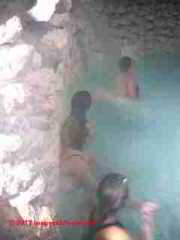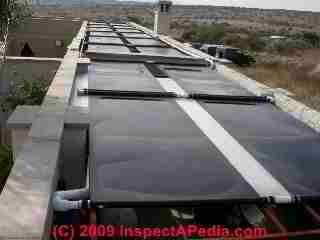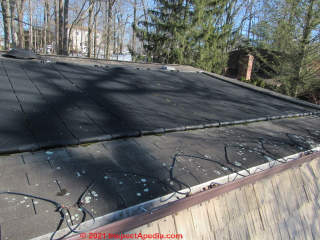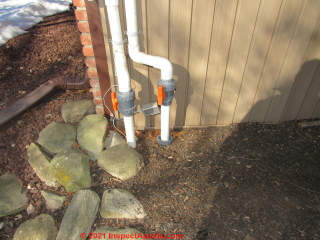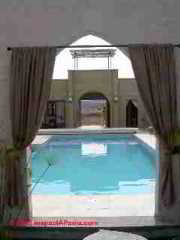 Swimming Pool Heaters
Swimming Pool Heaters
Choices, Troubleshooting, Installation & Repair
- POST a QUESTION or COMMENT about design, installation, maintenance & repair of solar swimming pool heating systems
Solar swimming pool heater troubleshooting:
Guide to outdoor swimming pool heater choices, methods, design, installation & troubleshooting. We explain the diagnosis of a poorly-performing outdoor solar swimming pool heating system. Sixteen solar panels installed on a flat roof are unable to raise the temperature of a swimming pool in Mexico.
This article describes the solar swimming pool heating system, followed by a discussion of diagnostic steps useful to determine why the solar heater performance was not satisfactory. Our page top photograph shows the 16 solar collector panels installed for a solar swimming pool heating system that was not working properly, viewed from the last panel pair (#15 and #16 in our sketch below).
InspectAPedia tolerates no conflicts of interest. We have no relationship with advertisers, products, or services discussed at this website.
- Daniel Friedman, Publisher/Editor/Author - See WHO ARE WE?
Types of Swimming Pool Heaters & Heated Water Sources/ Methods
[Click to enlarge any image]
A variety of methods are used to heat swimming pools both outdoors and inside. Our photo above shows a naturally-heated thermal spa, La Gruta, outside of San Miguel de Allende, in Guanajuato, Mexico. Thermal springs in the area feed a number of both public and private facilities.
Outside swim pool heating approaches include:
Use of a naturally heated water source such as thermal springs as a swim pool water supply.
At above left at La Gruta, a thermal hot springs located at Atontonilco, a historic site located about mid-way between San Miguel de Allende and Dolores Hidalgo in Guanajuato, Mexico.
Hot water from thermal springs that are throughout the area is routed through a cascade of pools at this and similar facilities in order to provide a range of water temperatures.
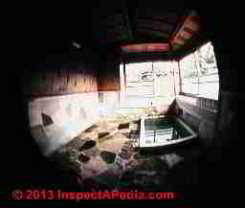
Naturally hot spring-fed baths are used world-wide where such waters are available, and may feed both outdoor (above) and indoor pools and spas.
At left we illustrate a traditional hot-spring fed bath at the home of family friend Keizo Ono, Tokyo, Japan, ca 1965.
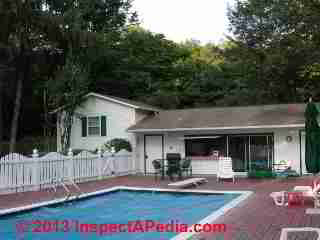
Using solar swimming pool covers
as a passive heat gain for swimming pool water and to slow the loss of heated water during cooler night time temperatures or re-stated: solar covers provide solar heat gain into the pool water and they also help keep heat in the pool.
Our photo of a solar cover for a swimming pool (left) illustrates this application in New York where a pool cover can extend the season of swimming pool use.
Typically the solar cover is a plastic bubble-type material. The clear or light-colored plastic bubbles act as lenses to help focus sunlight and solar heat gain into the swimming pool water.
Solar pool covers add about ten degrees F. to the temperature of the swimming pool water during sunny summer months, and by slowing heat loss during cooler nights, the total benefit of a solar swimming pool cover can be up to a 90% reduction in the cost to heat the pool, or more reasonably, a 70% reduction of heating costs for the swimming pool if the average daily temperature is above 50 °F.
See details at
- SWIMMING POOL COVERS [PDF] U.S. DOE - describes saving pool heating costs but a cover can also reduce swimming pool water loss by evaporation.
According to the DOE, use of a swimming pool cover can reduce the amount of make-up water needed by 30-50%.
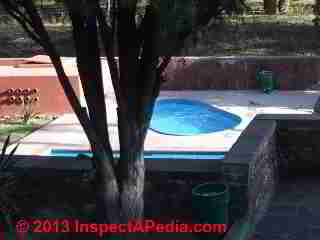
Using an active or passive solar panel system to heat swimming pool water is discussed in detail below.
Using an LP gas, natural gas, or oil fired swimming pool heater to heat the pool is one of the more common methods for heating residential and some larger public swimming pools.
Shown at left is a heated "Jacuzzi Spa" swimming pool at Lourdes, near Santa Maria del Rio in San Luis Potosi, Mexico.
This spa has been in continuous use since February 1931 and adjoins a bottling plant where natural spring waters high in mineral content (Aguas Minerales de Lourdes) are bottled for consumption.
While thermal hot spring water is available at the spa, including in private bathing rooms, the owners of the outdoor spa pool shown above have also installed a fuel-fired pool heater whose enclosure can be seen in the upper left of our photo.
Diagnosing a Cold Solar Heated Outdoor Swimming Pool - Installation Details
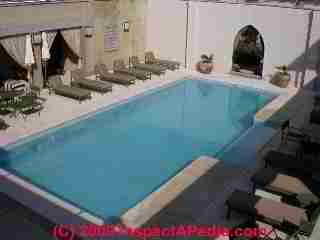
Solar Heated Swimming Pool - Sources of Pool Warmth
Special thanks to Ken Wright, Hot Sun Industries, Inc. for assistance in diagnosing this chilly solar heated swimming pool. Mr. Wright is a solar heating expert who designs, sells, and installs solar heating systems. Brett Knobel is the owner/operator of Shanti San Miguel, located in San Miguel de Allende, Guanajuato, Mexico. The plumbing "looked right" for this solar swimming pool heater. Why wasn't the system working?
We started the diagnosis of this chilly "solar heated swimming pool" by a visual inspection simply to see what equipment, piping, collectors, controls, valves, pumps, etc. were installed. The solar installation is described below:
At the time of our inspection and despite daily use of the solar pool heating system, the swimming pool was cool.
The solar swimming pool heating installation was about six months old and, according to the owner, had never worked.
About the only heat that this swimming pool was gaining in December 2009 was direct solar gain - sun shining on the swimming pool during the day.
Temperature of water entering the swimming pool from the solar collectors was about the same as the temperature in the pool itself - if indeed water was actually flowing through the collectors - something we needed to determine.
The swimming pool is about 12 x 20; 5 feet at the shallow end, 7 1/2 at the deep, about 100,000 liters in capacity.
At night the owner covers the pool to attempt to retain some of its warmth and turns off the pool pump.
Also see SWIMMING POOL SOLAR HEAT, INDOOR where we explain insulation, moisture, ventilation requirements.
See SOLAR COLLECTOR AIR or GAS COLLECTION where we explain gas collection problems and solutions for solar heated swimming pools.
Solar Swimming Pool Heating Panels
The solar swimming pool heating panels (photo at page top) appeared to be Solar Industries rigid polypropylene collectors made by Aquatherm Industries in NJ (no warranty - they private label everything).
The owner of the facility gave us the discouraging news that the original solar installer had left in bad graces. A second "engineer" had inspected the system, had the owners rotate the position of each of the sixteen panels 90 degrees, but had produced no improvement in the solar pool heater's performance.
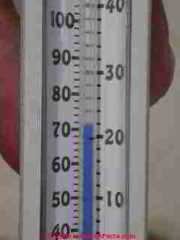
Solar Heated Swimming Pool Temperatures
The solar swimming pool heating system, sixteen 4 x 8 foot solar panels mounted on a rack above a flat roof, did not appear to be giving much heat to the swimming pool.
The pool temperature was 70 °F. when the heater started running (when sun hit the solar panels) and did not rise above 72 °F. during the day. We considered that this two degree temperature rise might be entirely due to direct solar gain on the pool itself.
We measured water temperature at the supply outlets into the pool from the solar heating system - and found the supply temperature to be about 72 °F.
So at most we were seeing a two degree temperature rise across the sixteen solar panels.
According to solar heating expert Ken Wright,
Solar pool heating is real simple. If it's black and its cold and it's in the sun then its delivering all solar energy it is exposed to the swimming pool. End of discussion. [Almost]
So we set out to check the temperature of the panels across their widths in full sun and tell Ken where the hot spots were found, if any.
Other possibilities besides an air-bound system were improper plumbing, improper pool control setup, or simply a valve that was in the wrong position somewhere in the system. We also considered the less likely (with plastic piping) problem of a blocked pipe.

Solar Pool Heater Controller
A Sun Touch Solar Controller for Swimming Pool Heating System was found installed.
When the pump is started, there is a big flush of water, which then subsides.
The engineer claimed the pump pressure is normal.
We do not have a vacuum breaker.
The collectors are always cold. (This sounds normal, but no temperature rise is being seen in the swimming pool).
The swimming pool pump runs from 9:45 to 5PM every day.

Solar Pool Heater System Water Pressure
Pressure at the swimming pool pump looked dangerously high to us. The pool filter had been freshly backwashed when we took this photo of the system pressure.
We were a little concerned about bursting a plastic pipe or other component. But according to the owner's engineer, this pressure, about 36 psi, was considered normal.
Wright and other solar swimming pool heater experts point out that we don't need much pressure to circulate pool water through the solar collectors, just enough to overcome the pressure created by the height of elevation of the collectors over the swimming pool. In fact, circulating water at higher pressure through the solar collectors can damage them and will reduce the efficiency of the system as well.
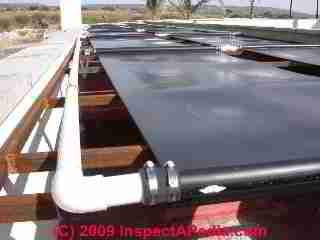
Swimming pool and solar pool heater piping:
The sixteen flexible solar panels are arranged in four banks of four 4x8 panels each.
Each bank of four panels is fed from the swimming pool pump, by a 1 1/2" PVC pipe manifold.
Our photograph (left) shows the 1 1/2" PVC supply manifold connected to solar panel No. 1, the first in the series. At each solar panel quad or bank, swimming pool water enters the input end of two solar panels in parallel, flows out of the bottom of this panel pair into the top of the second panel pair of the quad, and exits at the bottom of the second solar panel quad to pass through a return pipe to the pool pumping system.
The four "quads" of solar panels are piped in parallel, that is, swimming pool water flows through groups of four panels in parallel, and groups B, C, and D are provided with control valves to turn the flow on or off. Control valves permit turning off flow through three of the four solar panel banks.
The solar panel banks, while installed roughly level, are not all at the same elevation. The last four panels are roughly 6" lower than the middle six solar panels, and the first four panels are roughly 4" lower than the middle six panels.
Because each quad of solar panels has its own water feed piping in, these level differences may be unimportant. But other piping and connection details may have left air trap points in the system.
High and Low Points in the Solar Panel Swimming Pool Heater Installation

The installation of each quad of solar panels is roughly flat, but piping was found to be uneven, with some solar panel quad bank input or outlet manifolds tipped as much as 3" out of level.
But the levels of the quads of solar panels varied; the first quad, "A", comprised of panels 1, 2, 3, 4, was installed about six inches below solar panel quads B and C (the center eight panels in our sketch). Finally, solar panel quad D (panels 13, 14, 15, 16), was installed about four inches lower than the center quads B and C.
The panels were also not well supported on their steel frame, and we observed ponding after rainfall that might reduce the solar gain of the system during periods of intermittent rain and sunshine.
Ultimately the solar heated water returns to the swimming pool through eight jets installed around the pool sides.
There were no air bleeder points in the piping system, and no vacuum breaker drain-down valve. The system is not designed to drain down when the pump is turned off. A single check valve was located near the pool pump.
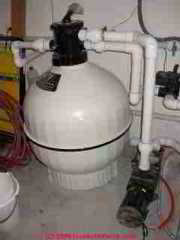
Swimming pool filter system (photo above left).
The swimming pool pump is visible, lower right, and the control valve routing water through the solar heating system or the gas fired pool heater is at the center right of this photo.
The swimming pool pump runs from 9:45 AM to 5PM every day.
A check valve is installed down-stream from the pump [need to confirm this location] but the system was not designed to "drain down" at night.
"When the pump is started, there is a big flush of water, which then subsides." reports the owner. [This may be diagnostic.]
This swimming pool pump output flow control valve intends to switch between routing water through the solar heating system and a separate Hayward LP gas fired swimming pool heater.
We wondered if it would make sense to provide another option to use both heating systems in parallel, routing solar output through the heater and thence to the pool.
NOTICE: We have not heard final resolution from the property owner who was to follow the diagnostic suggestions provided below. We will add that information here when we know the last chapter of this investigation of why the swimming pool stays too chilly.
Solar Swimming Pool Heating System Diagnostic Guide
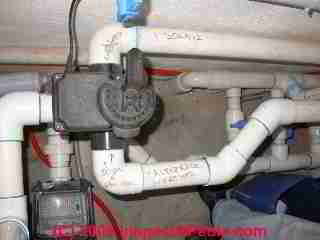 Readers may find it helpful to follow the solar pool heater diagnostic discussion below. We don't promise to hone in on the specific problem immediately - after all, we are diagnosing a non-heating solar pool system by email between two countries.
Readers may find it helpful to follow the solar pool heater diagnostic discussion below. We don't promise to hone in on the specific problem immediately - after all, we are diagnosing a non-heating solar pool system by email between two countries.
An on-site inspection by an expert is nearly always more complete, quick, and reliable. But reading our discussion (below) describes the sequence of investigation, discussion, and ultimate repair of the solar pool problem we have introduced above.
Our diagnostic discussion of this non-working solar pool heater is provided below, with the most recent comments listed first. Discussion was between Ken Wright, a solar pool heating expert, and Daniel Friedman, an experienced forensic investigator. Both investigators agreed to diagnose the pool heating system problem without compensation from the owner in exchange for her permission to use photographs of her system.
[Ken Wright to D Friedman (12/23) provided these solar pool heating system diagnostic questions and suggestions.]
Is water actually flowing through the solar collectors?
In diagnosing this non-heating solar swimming pool heating system, it is important to consider the fact that maybe the water isn't even flowing through the collectors. [That's why one of the first steps in diagnosing a too-cool solar heating system is to feel all of the solar panels, looking for temperature differences. A hotter panel is probably one that has less or no water flowing through it.]
Solar Heater Diagnosis - Install a clear check valve:
We always install a clear check valve on the return pipe so there is no doubt in the novice owner's mind as to whether or not the flow is going to the solar panels when it is sunny and the pool isn't up to temperature.
Is the solar pool heater controller set properly? Solar pool heater controllers have test modes meaning water could be just flowing to solar all the time, cooling the pool at night.
Are open valves really open and allowing water to flow? Or solar may not be working at all. Once we ran into a motorized valve that turned on the outside but the shaft inside was broken.
Are the solar heating system, pump, controls operating at correct pressure?
The only pressure gauge on the system we are discussing (see photos above) is at the pool filter and may not accurately represent the delivery pressure at the swimming pool pump. We need a pressure gauge at that location too. When we have really high pressure like that, we usually suspect the pressure gage is faulty. [Or its location is not measuring system pressure. See WATER TANK PRESSURE GAUGE for more about these devices.]
A good clue as to what is happening without a pressure gage is to look at the flow. A better way is to install a $10 pressure gage from the pool store. You can see swirl in the skimmer basket if there is good suction side flow. You can of course feel a strong force of water at each of the inlets to the pool.
At the subject swimming pool, we felt (by hand) good flow at the eight ports that deliver water into the swimming pool. -- DF
Pumps also make weird sounds of they are overloaded. Pool system water pressure has nothing to do with solar collector performance, only flow. Pressure and flow depend on each other of course. It's useful as a solar technician to understand what pressure is. Everyone in the business thinks they understand but very few have the slightest clue really. Videos at Mr. Wright's website provide a tutorial on this topic.
High pressure can damage solar collectors:
Pressure will cause the collectors to fail for sure in time. How much time? 6 months, 2 years. We have one system like this rigid polypropylene system in question in San Diego under 9 psi and its 5 years old. First we had to return to tighten up rubber removable couplings, then again. That was year one.
Then in year 2 we had to replace the rubber couplings with reinforced ones. Then in year 3 of the collectors sprang leaks. I wish the pool builder we'd fought with this over 3 years earlier had still been around so we could rebut his claim that he does this all the time and there is no problem with this small pressure.
The pool builder wanted to subcontract out for solar for the customer meaning he was doing the solar design yet he wasn't taking responsibility for the solar design. There is no such thing as solar design in his mind and he convinced our customer.
Three years later there we were changing the solar design, re plumbing the way solar tied in so the pressure was regulated. No more problems since. No pressure, no leaks. But all the while the system heated the pool just fine.
Excessive pressure and air blockage in solar pool heaters:
Excess pressure contributes to air blockage issues. The reason is we now
have a compressed bubble of air in the solar collectors. We have to flush that out upon startup. Flushing a compressed bubble of air down the return
pipe to the pool is more difficult than a zero pressure bubble of air.
A second explanation of the effects of high pressure air bubbles in any piping system we learned from oil burner heating school: a compressed air bubble expands to a much greater volume when the pressure on the system drops, making it still more difficult to "push" this air bolus around through the system at next pump start-up. --DF
This is where some of the finer points of solar troubleshooting and design come into play but if the pressure is low like it should be this issue almost disappears.
Solar pool heater with no vacuum breaker and no drain-down:
In the case we are discussing here, with no vacuum breaker the system is full of water all the time. The danger is that with the pump off in mid summer with the pool up to temperature the collectors could get as warm as 187 degrees. PVC plumbing
will collapse and so may the collectors. Depends how much suction pressure which depends on how high the roof is.
No drain down and missing check valves can convert a solar pool heater into a night time pool chiller:
On low elevations its not as critical to have a vacuum breaker, however the fear that water is migrating backwards cooling the pool is always a real fear.
A vacuum breaker is as simple as a one way valve teed off the pipe feeding the collectors. It doesn't let water out and it does let air in if there is a negative pressure. Ask the pool store for a 1/2 pound spring check valve. Don't ask for a vacuum breaker. They won't have one. At Hot Sun we use an actual brass vacuum breaker. (This valve is sold by HotSun).
Because we could not measure more than a degree or two of temperature difference between water leaving the pool and water returning to the swimming pool, we didn't think that a night-time pool chilling effect was the problem--DF.
Add a clear swing check valve to the return pipe on this system. Then we know 100% for sure when and if there is flow.
Solar Pool Heater: Initial Diagnostic Questions Posed to the Solar Heating Expert
[Daniel Friedman posed these questions to Mr. Wright.]
- The problem system that we are diagnosing is a solar pool heater in San Miguel de Allende, Mexico (described and photographed at the beginning of this article). Also pertinent to the operation of any solar collector system are the average temperatures in San Miguel - which we report separately
at WEATHER in SAN MIGUEL de ALLENDE.
We have as a solar swimming pool heating system, a flat rooftop system mounted on a metal grid using flexible solar panels. It's a new installation, the original installer is off the scene, a second "engineer" has looked at the system and had the owner change the direction of flow of all of the solar panels, but keeping the system flat - it didn't work before and didn't work after his suggestions and the owner is stymied. - This is a flat roof 16 flexible 4x8 profiled surface panel installation using flat plate style collectors, controlled by a SunTouch auto controller (Since the pool never reaches a cutoff temperature we were not sure what this control is doing - it might be improperly set.).
- Flat solar collector panels are piped in 4 sets of 4 4'x8' panels (16 panels total), no visible vacuum breaker, no temperature sensors, pressure sensors, flow sensors on the piping system. A manual isolation valve sends water from the pool pump through the solar panels or through a gas fired pool heater. (Not the layout I'd have recommended). A single check valve is located near the pump.
- At our initial site inspection we saw an inlet water temperature of 70 °F and water returning to the pool at just under 72 °F on a sunny December day (air temp in the high 70's or above).
- Pressure at the filter looks dangerously high (past the "Red zone") and over 20 psi at the filter - this may not be the delivery or flow through pressure on the system but it needs investigation;
- The solar heating panel system looks flat and may be air bound.
- We were not sure that the piping arrangement is correct. We had some concern that the outlet pressure from the first panels in the group might be providing backpressure on the outlet end of subsequent panel gangs, fighting flow through subsequent panel sets in the group.
- There is poor panel support, ponding (rain is seasonal here) but we doubt that the ponding would explain the very low temperature rise across the panels.
- The solar collector panels that we felt (we did not check every one - a critical diagnostic step) all felt about the same temperature, and all felt cool, but they had not had much sun yet at the time of our inspection.
- A Hayward pool heater fired by LP gas is installed but not in use.
Solar Pool Heater: Initial Diagnostic Questions & Advice Posed to the Owners
Photos above: a rooftop solar heating system for a swimming pool in Rockland County, New York, along with its piping extending down into the ground to bring heated water to the pool, courtesy of home inspector Dovber Kahn. His contact information is given below.
[Daniel Friedman wrote the solar pool heater diagnostic and inspection questions and suggestions below, offern them to the owner after an initial site inspection.]
- Check the solar collector surface temperatures
go on the bank of solar collectors on a sunny day, perhaps at 1 or 2 PM (or at solar "noon") when the system has been operating, and feel the solar collectors that you can safely reach. You should feel EVERY solar collector surface and compare the results.
If you find that some collectors are cool (correct conditions) and others quite hot (improper) then the hot collectors don't have water flowing through them.
When operating with water flowing through the solar collector, the panel will feel cool to the touch across its entire width. Near the feed or inlet side of the collector temperature may feel close to swimming pool temperature. Near the outlet end of the collector the temperature will feel warmer but should be only 5-10 degrees higher than the inlet temperature. - Swimming pool dimensions and capacity
Please give us the dimensions of the swimming pool itself, length, width, depth or average depth. - Air in the solar pool heating system
When you turn on the solar system and pool pump in the morning, do you see a big flush of air coming out of the roof panels and back down through the system into the pool?
You should see a big rush of air, stopping after a few minutes. If not, the system is not draining down when shut off, and/or it may be air-bound. We need to look into the air bound question because the solar pool heating system is installed roughly flat on the rooftop, but with some uneven, tilted piping (high spots) and with some banks of solar collectors at different levels than others. - Water pressure in the solar pool heating system and solar collector panels
did your engineer do any pressure checks on the system? Your pump pressure looks dangerously high at the filter. Provided the filter is clean there should not be high backpressure.
At the solar panels themselves, pressure should not be more than a few psi. The panels work best at very low pressure. If someone has set the pressure up to try to force the system to work, it's not helping and could risk injuring someone if a component breaks while someone is nearby.
Here are comments from an instruction manual for a solar pool heating system similar to the one discussed in this article:It's important to understand that unglazed solar panels such as Powerstrips are made of thermo-plastics, plastics that can withstand high temperature, but plastics cannot withstand high pressures like metals can when combined with the high temperatures.
Stagnating in Hot Sun and no wind, solar heater collectors of this type will get very hot. In making sure your solar system is compatible with your pool mechanical system we are making sure the system will operate stress free.
This means minimizing the pressure on the collectors. Any nonmetal solar collector will fail prematurely if installed under pressure regardless of the pressure capability the manufacturer claims. The fact is there is a lot of plumbing on the roof and a lot of water flowing and installing a solar system under pressure is asking for trouble in the long term.Most pool/roof combinations are suitable for a problem free solar heater and your dealer will always check first to make sure. Start up instructions at the start of this manual tell you to check the pressure in the collectors with a pressure gauge.
- Solar pool heater drain-down
Related to 3 above, did your engineer install a vacuum breaker on the system to allow air in and the system to drain down when off? For flat roof installations the vacuum breaker is on the pipe feeding into the solar panels.
We don't need to worry about freezing panels (and thus don't need to drain-down for that reason, but we were concerned that without seeing air moving through the system and out when the pump turns on, it may be air bound somewhere. - Be sure the pool pump is off at night
or that you turn off circulation through the solar panels so you are not accidentally COOLING the pool down at night through the panels.
Even with the pump off at night, if the system does not drain down when turned off and lacks effective check valves, the night time exposed solar collectors may actually be cooling the swimming pool by circulation that occurs by natural convection - working "backwards".
Solar Pool Heater Technical Specifications & Installation or Repair Guides
The U.S. DOE and other expert source solar pool heater guidelines documents we cite and provide below include simple formulas for calculating the BTU requirements for solar pool heaters as well as heating costs. Below we include some example specifications for solar pool heaters to help you assure that your design is likely to be functional.
- HSE Swimming Pool Heating Panels Specifications Sheet , Hotspot Energy, 4021 Holland Blvd. Chesapeake VA 23323 USA, Tel: 1-800-916-2067, International or Local: 1-757-410-8640, Website: http://www.hotspotenergy.com/, retrieved 2017/05/12, original source: http://www.hotspotenergy.com/solar-pool-heaters/HSE-solarpoolheatingspecs.pdf
- Solar Pool HEATING SYSTEMS [PDF], Solar Industries, 1940 Rutgers University Blvd. Lakewood, New Jersey 08701 USA Tel. 800-535-6307, Website: http://www.solarindustries.com/
- SOLAR SWIMMING POOL HEATERS, U.S. DOE , [PDF] U.S. Department of Energy, Office of Energy Efficiency & Renewable Energy Forrestal Building 1000 Independence Avenue, SW Washington, DC 20585, retrieved 2017/05/12, original source: https://energy.gov/energysaver/solar-swimming-pool-heaters
- SWIMMING POOL COVERS, ENERGY SAVINGS, U.S. DOE [PDF], Op. Cit., retrieved 2017/05/12, original source: https://energy.gov/energysaver/swimming-pool-covers
- US DOE, SOLAR WATER HEATERS [PDF] , U.S. Department of Energy article on solar domestic water heaters to generate domestic hot water in buildings, explains how solar water heaters work. Solar heat for swimming pools is also discussed.
- US DOE, HEAT EXCHANGERS for SOLAR WATER HEATING SYSTEMS [PDF], U.S. DOE describes the types of solar water heater heat exchange methods between the sun and the building's hot water supply
- US DOE, HEAT-TRANSFER FLUIDS for SOLAR WATER HEATING SYSTEMS [PDF] , U.S. DOE, describes the types of fluids selected to transfer heat between the solar collector and the hot water in storage tanks in a building. These include air, water, water with glycol antifreeze mixtures (needed when using solar hot water systems in freezing climates), hydrocarbon oils, and refrigerants or silicones for heat transfer.
- US DOE, SOLAR WATER HEATING SYSTEM MAINTENANCE & REPAIR [PDF] , U.S. DOE
- US DOE, SOLAR WATER HEATING SYSTEM FREEZE PROTECTION [PDF] , U.S. DOE,using antifreeze mixture in solar water heaters (or other freeze-resistant heat transfer fluids), as well as piping to permit draining the solar collector and piping system.
- US DOE, SCALING & CORROSION in SOLAR WATER HEATING SYSTEMS [PDF] U.S. DOE
- US DOE, ACTIVE SOLAR HEATING SYSTEMS [PDF] , U.S. Department of Energy, including
- US DOE, RADIANT HEATING SYSTEMS [PDF] U.S. DOE
- US DOE, ABSORPTION HEAT PUMPS & COOLERS [PDF] , U.S. DOE
- US DOE, SOLAR AIR HEATING [PDF] U.S. DOE also referred to as "Ventilation Preheating" in which solar systems use air for absorbing and transferring solar energy or heat to a building
- US DOE, SOLAR LIQUID HEATING [PDF] U.S. DOE, systems using liquid (typically water) in flat plate solar collectors to collect solar energy in the form of heat for transfer into a building for space heating or hot water heating. The term "solar liquid" is used for accuracy, rather than "solar water" because the water may contain an antifreeze or other chemicals.
- energysavers.gov/your_home/water_heating/index.cfm/mytopic=12850 was the original base U.S. DOE website for these articles
...
...
Continue reading at SWIMMING POOL SOLAR HEAT, INDOOR or select a topic from the closely-related articles below, or see the complete ARTICLE INDEX.
Or see SOLAR POOL HEATER REPAIR FAQs - questions & answers posted originally at this article
Or see these
Recommended Articles
- POOL CONCRETE COOL DECK SURFACES
- SCALD PROTECTION - for heated pools and hot tubs
- SOLAR COLLECTOR AIR or GAS COLLECTION
- SOLAR COLLECTOR EFFICIENCY COMPARISONS
- SOLAR COLLECTOR FILMS
- SOLAR COLLECTOR OUTGASSING
- SOLAR COLLECTOR WOOD HOUSINGS
- SOLAR ENERGY SYSTEMS - home
- SPA / HOT TUB / POOL MANUALS, PARTS, REPAIR, SUPPLIES
- SWIMMING POOL LEAK DETECTION
- SWIMMING POOL SOLAR HEAT, INDOOR
- SWIMMING POOL SOLAR HEAT, OUTDOOR DIAGNOSIS
- WEATHER in SAN MIGUEL de ALLENDE
Suggested citation for this web page
SWIMMING POOL SOLAR HEAT, OUTDOOR DIAGNOSIS at InspectApedia.com - online encyclopedia of building & environmental inspection, testing, diagnosis, repair, & problem prevention advice.
Or see this
INDEX to RELATED ARTICLES: ARTICLE INDEX to SOLAR ENERGY
Or use the SEARCH BOX found below to Ask a Question or Search InspectApedia
Ask a Question or Search InspectApedia
Try the search box just below, or if you prefer, post a question or comment in the Comments box below and we will respond promptly.
Search the InspectApedia website
Note: appearance of your Comment below may be delayed: if your comment contains an image, photograph, web link, or text that looks to the software as if it might be a web link, your posting will appear after it has been approved by a moderator. Apologies for the delay.
Only one image can be added per comment but you can post as many comments, and therefore images, as you like.
You will not receive a notification when a response to your question has been posted.
Please bookmark this page to make it easy for you to check back for our response.
IF above you see "Comment Form is loading comments..." then COMMENT BOX - countable.ca / bawkbox.com IS NOT WORKING.
In any case you are welcome to send an email directly to us at InspectApedia.com at editor@inspectApedia.com
We'll reply to you directly. Please help us help you by noting, in your email, the URL of the InspectApedia page where you wanted to comment.
Citations & References
In addition to any citations in the article above, a full list is available on request.
- [1] Ken Wright, Hot Sun Industries, Inc. 858-627-9007 San Diego, California, ken@h2otsun.com or www.h2otsun.com. Mr. Wright is expert at solar heating system design and installation.. Two educational videos on solar heating system installation are recommended by Mr. Wright. See www.h2otsun.com/pools - an extensive lesson on this subject. There is also a video at www.h2otsun.com/videos.html It's the last one on the page. Quoting from Mr. Wright:
Our company manufactures the Powerstrip solar pool heating system and we make these systems available to pool owners the world over through dealers and directly through our website. Solar pool heating system design and consultation are necessary parts of the process of marrying a solar pool heating system to a pool mechanical system. We're just the only company that includes this as part of our offering.
Everyone else sells collectors as if they are a simple commodity and too many people in the industry still think all you have to do is divert the water thru the black thing when the sun shines and your pool will be warm. When things leak or don't work its a big mystery and no-one takes responsibility.
Consumers must be very careful that their solar supplier is capable of troubleshooting their problems because if he can't figure out why the pool isn't getting warm or why the collectors keep failing, he can't deliver what the customer has paid for. And the story gets worse. Companies are still today selling epdm rubber tubing solar collectors. This material breaks down in chlorinated water. Powerstrip are not even in the rubber family. They are made of geon. This is an engineered thermoplastic based on pvc. It is completely inert to chlorine. Its the only flexible (freeze and shipping mishandling proof) non epdm collector available in the US. - [2] Brett Knobel, Shanti San Miguel, San Miguel de Allende, Mexico info@shantisanmiguel.com operates this new spa, restaurant, and outdoor swimming pool just outside of San Miguel de Allende, Guanajuato, Mexico. Cell: 044-415-151-8289. Quoting from SSM's website:
In India, it is said that the guest is a god, and that's how we want you to feel here at Shanti. Whether you come for a full day of yoga, swimming, Indian food and massage, or just to lie on a divan and watch the clouds float by, or even just to relax on the roof deck with a cocktail and some friends--be prepared to be treated like a god. - Our recommended books about building & mechanical systems design, inspection, problem diagnosis, and repair, and about indoor environment and IAQ testing, diagnosis, and cleanup are at the InspectAPedia Bookstore. Also see our Book Reviews - InspectAPedia.
- In addition to citations & references found in this article, see the research citations given at the end of the related articles found at our suggested
CONTINUE READING or RECOMMENDED ARTICLES.
- Carson, Dunlop & Associates Ltd., 120 Carlton Street Suite 407, Toronto ON M5A 4K2. Tel: (416) 964-9415 1-800-268-7070 Email: info@carsondunlop.com. Alan Carson is a past president of ASHI, the American Society of Home Inspectors.
Thanks to Alan Carson and Bob Dunlop, for permission for InspectAPedia to use text excerpts from The HOME REFERENCE BOOK - the Encyclopedia of Homes and to use illustrations from The ILLUSTRATED HOME .
Carson Dunlop Associates provides extensive home inspection education and report writing material. In gratitude we provide links to tsome Carson Dunlop Associates products and services.


